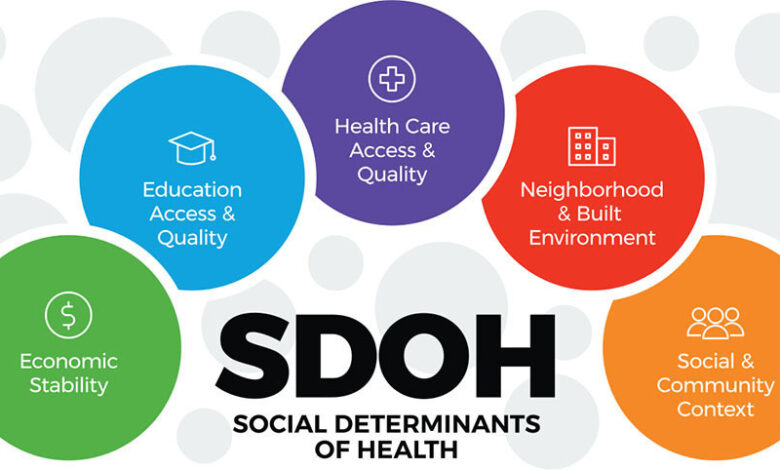
Doing the Nitty-Gritty–Using SDOH
As someone who has done or taught discharge planning for many years, one key component that holds true for me today is that when discharge planning assessments are performed, especially on those very complex cases, they must be very comprehensive. It is amazing as I look back, and unbeknownst to me, I used social determinants of health (SDOH) components when I worked with my family on the discharge plan. This was long before SDOH became a buzzword. As our healthcare system evolves and we deal with a more complex mix of patients with various care needs, reviewing and addressing these factors is critical as the discharge plan is developed. If not, you will have a plan that is not only unsafe but unsustainable.
SDOH has been around in healthcare for about 12 years, so this should not be a new term for you. However, as a refresher, SDOH refers to the non-medical factors that affect health outcomes, including the conditions in which we are born, grow, work, live and age (reference 1). In broader terms, SDOH ensures everyone has a chance to achieve optimal health outcomes as SDOH includes factors that affect:
- Our economic stability, including our employment history, income, cost of living, food security and housing stability.
- Our education level and attainment, language, literacy, early childhood education, and development and the impact this has on our health.
- The environment, cultural and religious norms that affect our health and wellbeing and how we live, learn, work and play.
- Our ability to access healthcare and understand healthcare service recommendations and health insurance coverage. The key is English proficiency and health literacy, and, if an immigrant, the health implications for persons who migrate to or move about our country.
- Our ability to access transportation, obtain quality housing, healthy food, water and air quality.
- The history of our housing and community regarding prejudice, discrimination, violence and crime (reference 2).
Using SDOH as discharge plans or resource linkage seems more critical each year. Why? We now deal with a wider variety of patients, constituting a different mix than we have historically seen. To complicate the issue, we are also dealing with shortages of healthcare resources at all levels as we see an older population, including many healthcare professionals, all living longer. This means many (both patients and their caregivers) are living with some form of dementia or with multiple chronic medical conditions or co-morbidities, often living on minimal incomes, which means they will struggle with the care needed as there is no alternative. So, we have the “blind leading the blind” as care is attempted. We are also dealing with a larger group of patients who are living longer due to the many advances of medicine again with multiple co-morbidities, a wide variety of mental health conditions, or those who require repeated readmissions for either complications or ongoing needs for the administration of a costly medication or procedure. These are all topped by a population who live in a neighborhood that is riddled with violence, drugs, and sex trafficking, or are homeless—any one of which makes the discharge planning process complicated.
Complicating the picture is that many patients are uninsured or may have “insurance.” Still, it is surprising to the innocent layperson that while this “insurance” comes with low premiums, it has unexpectedly high co-payments and deductibles or no coverage for specific services if care is required—as they often do not qualify for public programs (Medicaid). They then fall into the gray area—too much to access programs and too little to pay for care. This and poverty and low incomes equate to patients foregoing needed care, medications or the right location for their care as they cannot afford it. For the homeless, mentally ill or substance abusers, their care, if they get it, is frequently provided only by the local emergency departments or “street nurses” from a local clinic that serves the homeless population. To further complicate the issue, hospitals are challenged with what to do with these patients since patients’ post-acute care needs are often as complicated as care while hospitalized in the acute hospital.
Thus, it may take a “village” to help plan as care conferences are held and care plans are developed. This village will then use critical input from the patient, family, multidisciplinary team members and possibly previously used outside agency staff as care needs and the SDOH, ideas or suggestions are discussed. From this, it may then take the case manager hours as community resources are explored for appropriate linkage at discharge.
Unfortunately, as the level of care from post-acute resources may be in short supply, the linkage for the right level of care may be delayed as many providers have long waiting lists because they are not equipped to manage the amount of care often required for patients needing a post-acute provider. Complicating matters frequently boil down to financial reimbursement, or the family’s ability to afford the level of care needed is direly lacking.
When dealing with the elderly or even medically complex younger patients, families are not equipped physically or, at times, financially to manage the care needed. We often see an older spouse attempting to care for their loved ones, yet they have had little or no training. On top of this, the caregiver frequently suffers from a mental or health issue as well, not to mention they are too frail or lack the eyesight or dexterity to perform the tasks required. For this same older population, we now have our healthcare system impacted with the intellectually and developmentally disabled (IDD) living longer, often now with dementia or Alzheimer’s disease, while being cared for by an aging parent or sibling, with possibly the same medical issues. Let us not forget all those baby boomers now impacting our healthcare system of already limited postacute care resources.
For the younger population, if married or with under-age children—this adds extra stress as to who will be the breadwinner while also managing child-rearing needs and attempting to provide the care their loved one needs. For the homeless and substance abuse users, these present their own set of problems, especially if medical care or intravenous medications are required upon discharge, and there are limited or no financial resources to pay for care or their previous lifestyle behavior has set the tone that assuming care by a provider will be impossible to manage.
Finding resources is not easy for any of the patients mentioned above. Even if the physician has deemed the patient ready for discharge, long stays can be encountered if resources cannot be located or if a public conservator is required, as an agent must be appointed to help manage the care and access the finances needed to pay for care.
Any one of the preceding means hospitals are faced with avoidable or variable days, all of which are low-hanging fruit for a denial from the insurer, which makes it nearly impossible to appeal and win the appeal. These patients also impact a hospital’s length of stay metrics, daily census and hospital throughput. If the patient has limited income and this is the barrier to discharge, hospitals must become creative with how the bill can be paid for the ongoing care from a post-acute care setting the patient requires.
Thus, it is imperative that as case managers conduct the initial and ongoing assessments, they apply what I call a “nitty-gritty” approach. For those complex or total care patients, case managers must look at and explore every detail from the norm as they complete an assessment, starting their research and possibly referrals as soon as needs are identified. This means as case managers review the medical record or interview the patient, family and/or medical team, they must then “dig deep” and ask, at times, hard questions to ensure any unforeseen needs and, equally as important, who and where will the money come from, are addressed as early as possible.
Case managers must not wait until the discharge approaches to start any education the patient and family may require, and this education must include alerting them to make use of technology and explore any state or federal programs that might assist to pay for care. This means exploring:
- What Social Security (SS) programs might the patient be eligible for? This includes all ages. For example, families can now explore SS and information on a program for:
- A child under the age of 18 who is disabled either physically, developmentally, or has an intellectual impairment.
- Patients over the age of 18 are considered “disabled” if they have a medically determinable physical or mental impairment (including an emotional or learning problem) that will result in the inability to do any substantial gainful employment activity and can be expected to result in death or has lasted or can be expected to last for a continuous period of not less than 12 months.
- A patient who is blind or disabled under age 65.
- A patient who is a non-citizen but who is determined to be a “qualified alien” (reference 3).
Other programs to explore as early as possible include:
- If the patient is a veteran, encourage the patient or family to explore any care options, including home modifications, available under the Veterans Administration for eligible veterans. If the spouse will be the caregiver, one critical program is to have them explore eligibility for the VA’s Aid and Attendant Care program (reference 4).
- If the patient is already or will be eligible for the state’s Medicaid program, have the patient or family explore and apply for any potential waiver programs the state offers. This is critical as most waivers are impacted and have a long waiting list (reference 5).
- If a child under age 19 has a serious medical condition requiring institutional care at discharge, ensure the family explores the Katie Beckett or TEFRA waiver program (reference 6).
- If the disability occurred before the age of 19, explore applying to the area’s Developmentally Disabled Services program (reference 7).
- If a child under age 21 has a medical condition that fits the state’s Children and Youth with Special Health Care Needs (CYSHCN) program, they can apply for it (reference 8).
- If the patient is 55 or older and has both Medicare and Medicaid and a PACE (Program of All-inclusive Care for the Elderly) program is in the area, have the patient or family apply for such a program. Again, there may be a waiting list, but get the patient on it as soon as possible (reference 9).
- Regardless of age, any agencies related to the patient’s diseases should be explored for potential services or programs from which the patient may benefit.
The nitty-gritty approach also helps to identify the simple stuff needed at discharge. For example, where and how will the patient get their care—will it be from a home health agency, or can care be obtained from an outpatient facility? Other questions will be how and where they can get their medications; will they have transportation to and from any follow-up service appointments? If not, is there a city-disabled public transportation system, or might something be available from a local disease-specific organization? Do they have or need proper durable medical equipment to fit their size (remember if they are over a specific weight or girth, they may need bariatric or heavy-duty equipment)? Also, if care is to be at home and provided by the family caregiver, ensure they have the correct items and equipment (taking into account the age, diagnosis and behavior of the patient) to provide the care while ensuring they or their loved one is not injured as care is provided. Equally necessary if the family is to be the caregiver, ensure the team trains the caregiver, using the teach-back method on all levels of care, even the basics.
So, as you do your assessments, take them to the next level, dig deep and learn the nitty-gritty approach. In the long run, it helps establish correct linkage, prevent unnecessary readmissions, ensure a safer discharge and increase patient satisfaction as they are not more than a yo-yo back and forth and in and out of the acute hospital. Remember, the final plan is not yours—but the one the patient and family can use as they navigate the healthcare system.





